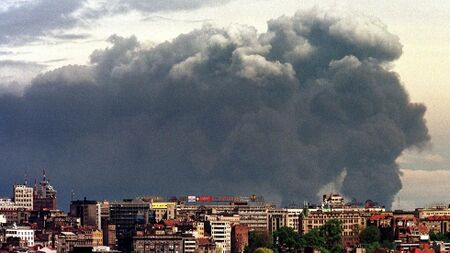Zemplen Conflict
| Zemplen Conflict | |||||||||
|---|---|---|---|---|---|---|---|---|---|
 Smoke rises over Sopron during the Zemplen War | |||||||||
| |||||||||
| Belligerents | |||||||||
|
|
| ||||||||
| Units involved | |||||||||
|
Imperial Armed Forces of Ruvelka Ruvelkan Red Army (1865-1918) |
Syaran Commonality Armed Forces Army of the Syaran Republic (1875-1983) | ||||||||
| Strength | |||||||||
| 3,344,200 troops 2020 | 3,750,000 troops 2021 | ||||||||
| Casualties and losses | |||||||||
|
730,000 (Galanian-Ruvelkan War) 465,000 (Ruvelkan-Makedonian War) 2,125,000 (Syaran-Ruvelkan War) 10,000 (Ruvelkan Civil War) 220,000 (Granika Border War) 2,957,577 (Zemplen War) Total: 6,507,577 |
620,000 (Galanian-Ruvelkan War) 265,000 (Ruvelkan-Makedonian War) 1,750,000 (Syaran-Ruvelkan War) 5,000 (Ruvelkan Civil War) 172,000 (Granika Border War) 2,430,123 (Zemplen War) Total: 5,242,123 | ||||||||
The Zemplen Conflict is an ethnic and territorial conflict between Ruvelka and Syara over the disputed region of Zemplen. Zemplen is inhabited predominantly by ethnic Karvelebi, who in the modern era more closely align with Ruvelka. Zemplen has been under the control of Ruvelka since the Zemplen War, where Syara ceded the region as part of the Treaty of Aragon.
Zemplen has been inhabited by the Karvelebi (part of the Kartozan family) since antiquity. The region was part of of the Makedonian Empire and Makedonian Khanate, and was later incorporated into the Rioni Union in the 17th Century. Following the dissolution of the Union, control of Zemplen fell to the Ruvelkan Imperium, which later contested rule of Zemplen with neighboring Kingdom of Galania during the Galanian-Ruvelkan War. The Kingdom of Makedon gained control of Zemplen following the Ruvelkan-Makedonian War, and afterwards became part of the Republic of Syara following the Unification of Syara. Ruvelka gained control of most of Zemplen following the Syaran-Ruvelkan War, but Syara regained Zemplen during their intervention in the Ruvelkan Civil War.
Zemplen remained a part of Syara following the Siduri War, despite Ruvelkan insistence on regaining Zemplen during negotiations of the Treaty of Debrecen. During the Granika Border War, Zemplen was the site of several clashes between Ruvelka and Syara, which sometimes involved the separatist group SDM in such events as the Seven Day War. Syara remained in control of Zemplen following the Refusal War, after which the region became embroiled in clashes between the SDM and the Syaran Commonality in what became known as the Zemplen Resolution Campaign. Disputes and fighting over Zemplen eventually culminated in the Zemplen War itself, the largest military confrontation between Syara and Ruvelka since the Siduri War. Ruvelkan victory in the conflict resulted in the Principality regaining control of Zemplen for the first time in nearly a century, where it remains to this day.
Despite the treaty tensions between the two states remain high and public sentiment in both nations express strong opinions regarding ownership of Zemplen. Zemplen is of particular historical importance to Syaran national history owing to the location of the Nemaro battlefield. However most Karvelebi, the largest ethnic group in Zemplen, report closer political and cultural affinity with Ruvelka. Tensions and conflicts over and related to Zemplen have claimed the lives of nearly 10 million people since the formation of modern Zemplen in the 18th Century. Instances of genocide and campaigns of ethnic cleansing over the centuries have been carried out by both Ruvelka and Syara, resulting in the deaths of an estimated 500,000 to 2,500,000 people over the course of the conflict.